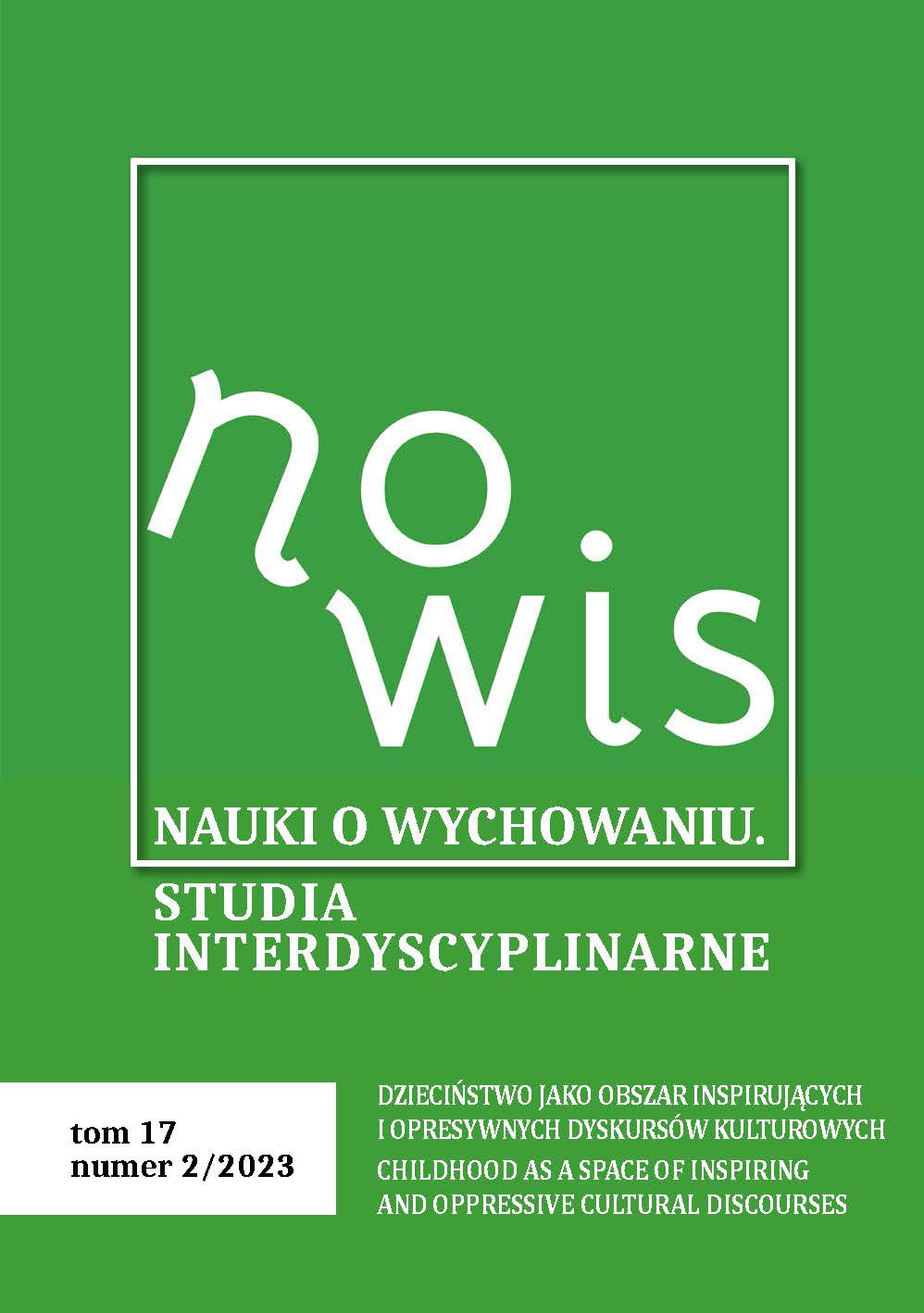Identification of a Child’s Creative Potential: Test, Observation, or Dialogue? Main Themes of the Discourse
DOI:
https://doi.org/10.18778/2450-4491.17.04Keywords:
child’s creativity, diagnosis of creative potential, integrated diagnosis, portfolio methodAbstract
The subject of the article is the diagnosis of children’s creativity in its two varieties: diagnosis of creative potential and diagnosis of effectiveness, generally based on psycho- metric measurement. The author briefly characterizes both types of diagnoses, and then goes on to criticize their shortcomings and limitations, which are still the subject of dispute among their supporters. Finally, he proposes to appease these disputes by developing an integrated diagnosis model that combines the study of all aspects of creativity: products, people, the process of creation, and the creative environment, with the use of dialogue and through analyzing children’s narratives. Giving voice to the creative child and the systematic collection and analysis of his or her various achievements in the form of a portfolio is the essence of this model of diagnosis, which is to fulfill an important prognostic and developmental function.
References
Amabile T. M. (1996) Creativity in Context. Update to the Social Psychology of Creativity, Boulder, Westview Press.
Google Scholar
Cropley A. J., Cropley D. (2009) Fostering Creativity. A Diagnostic Approach for Higher Education and Organizations, Cresskill, Hampton Press Inc.
Google Scholar
Dąbrowski K. (1979) Dezintegracja pozytywna, Warszawa, Państwowy Instytut Wydawniczy.
Google Scholar
Faulkner D., Coates E. (2011) Exploring Children’s Creative Narratives: Some Theoretical, Methodological, and Applied Perspectives in: Exploring Children’s Creative Narratives, D. Faulkner, E. Coates (eds.), London, Routledge, pp. 1–11, https://doi.org/10.4324/9780203818923
Google Scholar
DOI: https://doi.org/10.4324/9780203818923
Gralewski J. (2022) Niedostrzegana kreatywność. Trafność ocen kreatywności uczniów dokonywanych przez nauczycieli liceów i jej uwarunkowania, Warszawa, Wydawnictwo Akademii Pedagogiki Specjalnej.
Google Scholar
Helson R. (1999) A Longitudinal Study of Creative Personality in Women, “Creativity Research Journal”, no. 12, pp. 89–101, https://doi.org/10.1207/s15326934crj1202_2
Google Scholar
DOI: https://doi.org/10.1207/s15326934crj1202_2
Johnson A. S., Fishkin A. S. (1999) Assessment of Cognitive and Affective Behaviors Related to Creativity in: Investigating Creativity in Youth. Research and Methods, A. S. Fishkin, B. Cramond, P. Olszewski-Kubilius (eds.), Cresskill, Hampton Press, pp. 265–306.
Google Scholar
Just M. (2013) Efektywność treningu w tworzeniu analogii i metafor w edukacji uczniów klas I–III, manuscript of doctoral disseration written under the supervision of prof. dr hab. K. J. Szmidt, Wydział Nauk o Wychowaniu UŁ, Łódź.
Google Scholar
Kettler T., Lamb K. N., Mullet D. R. (2018) Developing Creativity in the Classroom. Learning and Innovation for 21st-Century Schools, Waco, TX, Prufrock Press Inc.
Google Scholar
Klus-Stańska D. (2019) Formatowanie dziecka i dzieciństwa. Kontrowersje wokół rozumienia rozwoju w diagnostycznym paradygmacie pedagogiki in: Horyzonty dziecięcych znaczeń. Granice – rozpoznania – perspektywy, M. Wiśniewska-Kin, J. Bonar, A. Buła (eds.), Łódź, Wydawnictwo Uniwersytetu Łódzkiego, pp. 13–31, https://doi.org/10.18778/8142-231-4.02
Google Scholar
DOI: https://doi.org/10.18778/8142-231-4.02
Kubicka D. (2000) Kontrowersje wokół pomiaru twórczości u dzieci, “Psychologia Wychowawcza”, no. 2–3, pp. 208–220.
Google Scholar
Kubicka D. (2003) Twórcze działanie dziecka w sytuacji zabawowo-zadaniowej, Kraków, Wydawnictwo Uniwersytetu Jagiellońskiego.
Google Scholar
Plucker J. A., Makel M. C., Qian M. (2021) Assessment of Creativity in: Creativity. An introduction, J. C. Kaufman, R. J. Sternberg (eds.), New York, Cambridge University Press, pp. 46–67, https://doi.org/10.4324/9781003233930
Google Scholar
DOI: https://doi.org/10.1017/9781108776721.005
Płóciennik E. (2010) Stymulowanie zdolności twórczych dziecka. Weryfikacja techniki obrazków dynamicznych, Łódź, Wydawnictwo Uniwersytetu Łódzkiego, https://doi.org/10.18778/7525-523-2
Google Scholar
DOI: https://doi.org/10.18778/7525-523-2
Qian M., Plucker J. A. (2017) Creativity Assessment in: Creativity & Innovation. Theory. Research and Practice, J. A. Plucker (ed.), Waco, TX, Prufrock Press Inc., pp. 223–235, https://doi.org/10.4324/9781003233930-17
Google Scholar
DOI: https://doi.org/10.4324/9781003233930-17
Said-Metwaly S., Kyndt E., Van den Noortgate W. (2017) Approaches to Measuring Creativity: A Systematic Literature Review, “Creativity: Theories – Research – Application”, v. 4, no. 2, pp. 238–275, https://doi.org/10.1515/ctra-2017-0013
Google Scholar
DOI: https://doi.org/10.1515/ctra-2017-0013
Saracho O. N. (2012) Young Children’s Creativity in a Contemporary World in: Contemporary Perspectives on Research in Creativity in Early Childhood Education, O. Saracho (ed.), Charlotte, Information Age Publishing, pp. 399–416.
Google Scholar
Sawyer R. K. (2012) Explaining Creativity: The Science of Human Innovation, 2nd edition, New York, NY, Oxford University Press.
Google Scholar
Staniszewska O. (2014) Zabawka twórcza w opiniach uczniów szkoły podstawowej, manuscript of MA disseration written under the supervision of prof. dr hab. K. J. Szmidt, Wydział Nauk o Wychowaniu UŁ, Łódź.
Google Scholar
Szmidt K. J. (2003) Czy twórczość można zmierzyć? Spory wokół psychometrycznych metod badania twórczości in: Twórczość – wyzwanie XXI wieku, E. Dombrowska, A. Niedźwiedzka (eds.), Kraków, Oficyna Wydawnicza “Impuls”, pp. 39–59.
Google Scholar
Szmidt K. J. (2009) Współczesne podejścia w pedagogicznych badaniach nad twórczością: przegląd wybranych stanowisk in: Metody pedagogicznych badań nad twórczością. Teoria i empiria, K. J. Szmidt (ed.), Łódź, Wydawnictwo AHE, pp. 13–102.
Google Scholar
Szmidt K. J. (2013) Pedagogika twórczości, second expanded edition, Sopot, Gdańskie Wydawnictwo Psychologiczne.
Google Scholar
Szmidt K. J. (2016) Kluczowe kompetencje nauczyciela twórczości jako diagnosty in: Diagnozowanie twórczości uczniów i nauczycieli, B. Niemierko, M. K. Szmigel (eds.), Kraków, Polskie Towarzystwo Diagnostyki Edukacyjnej, pp. 25–40.
Google Scholar
Szmidt K. J. (2019) ABC kreatywności. Kontynuacje, Warszawa, Difin.
Google Scholar
Treffinger D. J., Schoonover P. F., Selby E. C. (2013) Educating for Creativity and Innovation. A Comprehensive Guide for Research-Based Practice, New York, Routledge, https://doi.org/10.4324/9781003234784
Google Scholar
DOI: https://doi.org/10.4324/9781003234784
White K. (2019) Unlocked. Assessment as the Key to Everyday Creativity in the Classroom, Bloomington, Solution Tree Press.
Google Scholar
Wiśniewska-Kin M. (2009) “Miłość jest jak wiatrak” – czyli o poznawczej naturze metafor dziecięcych, Łódź, Wydawnictwo Uniwersytetu Łódzkiego.
Google Scholar
Wiśniewska-Kin M. (2013) Dominacja a wyzwolenie. Wczesnoszkolny dyskurs podręcznikowy i dziecięcy, Łódź, Wydawnictwo Uniwersytetu Łódzkiego, https://doi.org/10.18778/7525-794-6
Google Scholar
DOI: https://doi.org/10.18778/7525-794-6
Zwiernik J. (2015) Podejścia badawcze w poznawaniu wiedzy dziecka, “Teraźniejszość – Człowiek – Edukacja”, no. 1(69), pp. 81–103.
Google Scholar
Zwiernik J. (2019) Partycypacyjne badania dzieci jako proces emancypacyjny in: Horyzonty dziecięcych znaczeń. Granice – rozpoznania – perspektywy, M. Wiśniewska-Kin, J. Bonar, A. Buła (eds.), Łódź, Wydawnictwo Uniwersytetu Łódzkiego, pp. 47–61, https://doi.org/10.18778/8142-231-4.04
Google Scholar
DOI: https://doi.org/10.18778/8142-231-4.04






 The journal's website, created and edited by the NOWiS Editorial Team on the Index Copernicus platform:
The journal's website, created and edited by the NOWiS Editorial Team on the Index Copernicus platform: 





